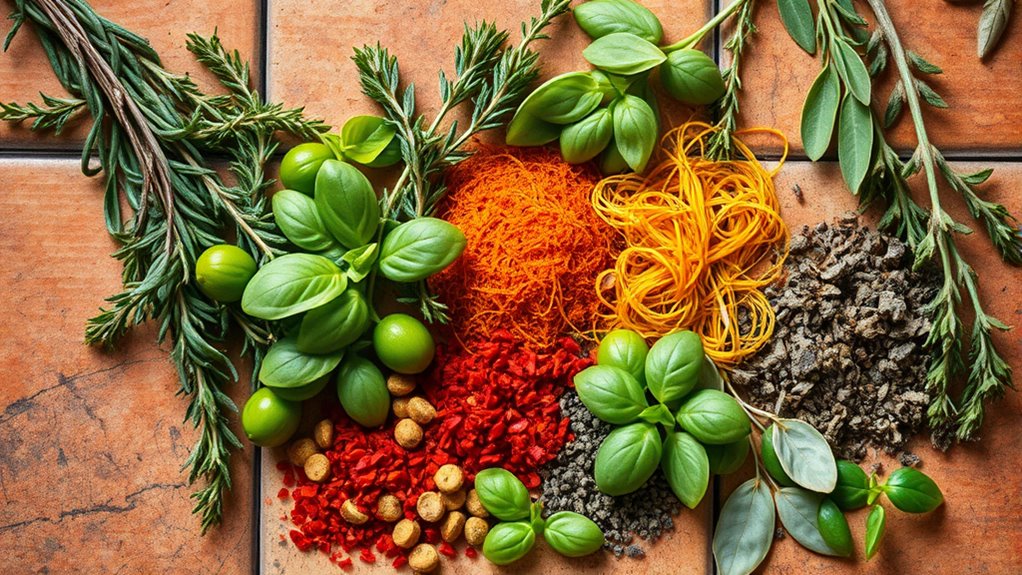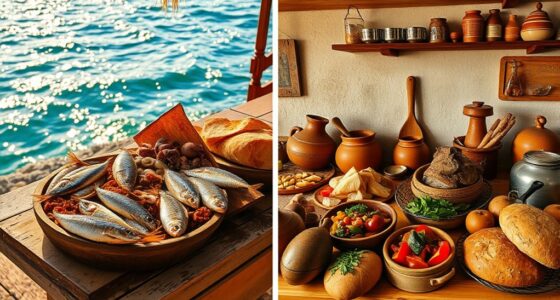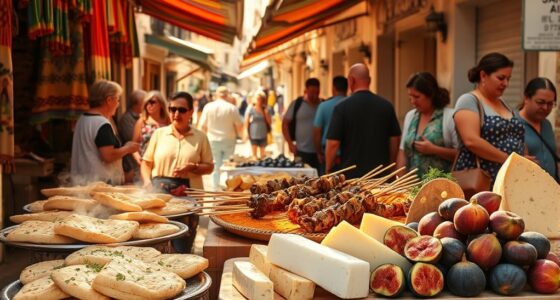Discover the rich world of Sardinian herbs and spices, where native plants like rosemary, thyme, myrtle, and saffron play key roles in cooking and healing. These herbs are used fresh, dried, or infused in traditional dishes, herbal blends, and remedies to support digestion, respiratory health, and cultural rituals. If you continue exploring, you’ll uncover how these aromatic plants enhance both flavor and wellness in Sardinian life.
Key Takeaways
- Sardinian herbs like rosemary, thyme, myrtle, and wild fennel are native and used for their aromatic and medicinal properties.
- Traditional blends include fresh herbs such as parsley, basil, and laurel, used in regional soups, sauces, and meat dishes.
- Herbs are preserved through drying, freezing, or infusing in vinegar, maintaining their flavor and health benefits.
- Sardinian spices like saffron, myrtle, and fennel contribute distinctive colors and aromas to local seafood and meat recipes.
- Cultural practices incorporate herbal infusions and rituals for health, protection, and spiritual well-being, reflecting deep botanical traditions.
Key Aromatic Herbs of Sardinia

Sardinia’s aromatic herbs are an indispensable part of its culinary and medicinal traditions, with native plants that thrive in the island’s unique Mediterranean climate. You’ll find rosemary, which adds a piney, woodsy aroma to meats and vegetables, and also offers antioxidant benefits. Thyme, common in wild collections, provides a strong scent and supports respiratory and digestive health. Myrtle, used fresh or dried, imparts a sweet, resinous fragrance and is traditionally applied for respiratory issues and flavoring in liqueurs. Wild fennel gives dishes a mild anise flavor and aids digestion, while saffron, a prized spice, infuses dishes with a golden hue and subtle aroma. These native herbs are vital to Sardinian cuisine’s distinct character and healing practices.
Traditional Sardinian Herb Blends
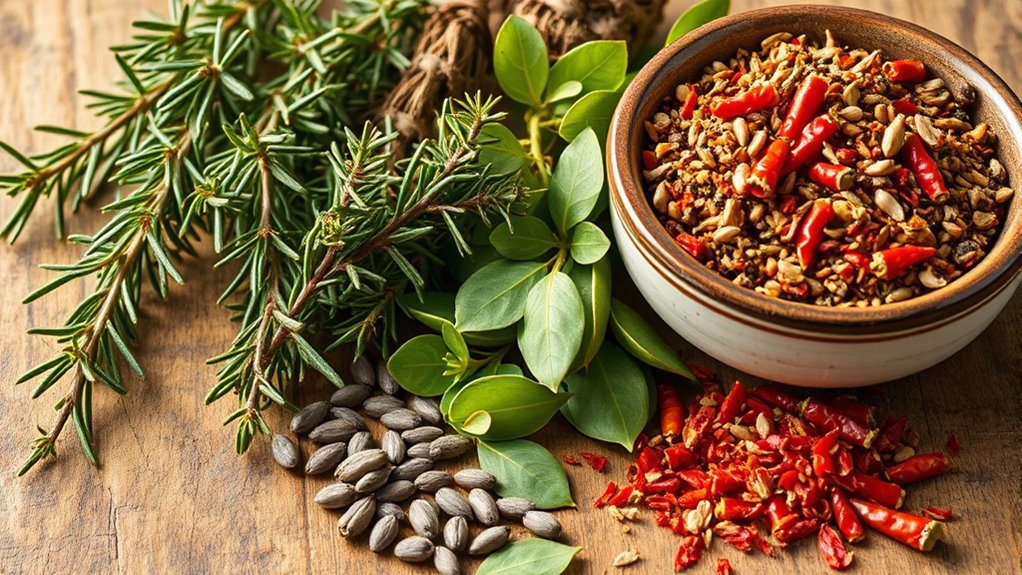
You’ll find that Sardinian herb blends typically include fresh foraged herbs like parsley, tarragon, fennel leaves, and arugula, creating a fragrant, herby flavor. These mixes are used in soups, salads, and stuffing, adding both aroma and depth to dishes, while also offering potential health benefits. Their composition varies by region and season, reflecting local herbs’ availability and traditional preferences. Fregola, an Italian toasted pasta, is often incorporated into dishes with these herbs for its chewy texture and ability to complement soups beautifully.
Key Herb Components
Traditional Sardinian herb blends feature a carefully curated selection of key components that define their distinctive flavors. Parsley, with both stems and leaves, offers a fresh, vibrant taste, while arugula adds a peppery kick. Tarragon brings a subtle anise-like aroma, enhancing the complexity of the blend. Chives contribute a mild onion flavor, especially in soups like S’erbuzu, and Italian parsley adds a bright, green freshness. For more aromatic depth, myrtle delivers a sweet, minty note, and rosemary provides a piney, fragrant aroma. Laurel introduces warmth with its slightly bitter taste, complemented by earthy sage and sweet fennel, which offers aniseed sweetness. These components are combined in various proportions, depending on regional traditions, seasonality, and personal preference, creating the foundation of authentic Sardinian herb flavors. Herb blending techniques are often passed down through generations, ensuring the preservation of traditional flavors and methods.
Culinary and Medicinal Uses
Herb blends are a cornerstone of Sardinian cuisine and traditional medicine, enriching dishes with vibrant flavors and offering health benefits. You’ll find these herbs in soups like S’erbuzzu, where foraged greens, beans, pasta, and meats create hearty, rustic meals. Fregola, a toasted pasta, pairs perfectly with herb mixes, adding texture. Key ingredients like parsley, fennel seeds, arugula, and tarragon deliver aromatic and nutritional value. Fresh herbs are also used in salads and stuffed vegetables for added flavor. Many herbs, such as tarragon, fennel, parsley, and garlic, have medicinal properties—supporting digestion, reducing inflammation, and boosting immunity. These blends are often added at the end of cooking to preserve their medicinal compounds, aligning with Sardinia’s emphasis on healthy, longevity-promoting eating. Incorporating traditional candy innovations like cotton candy grapes into diets highlights a modern twist on natural flavors, combining health-conscious choices with culinary creativity.
Culinary Uses of Sardinian Herbs
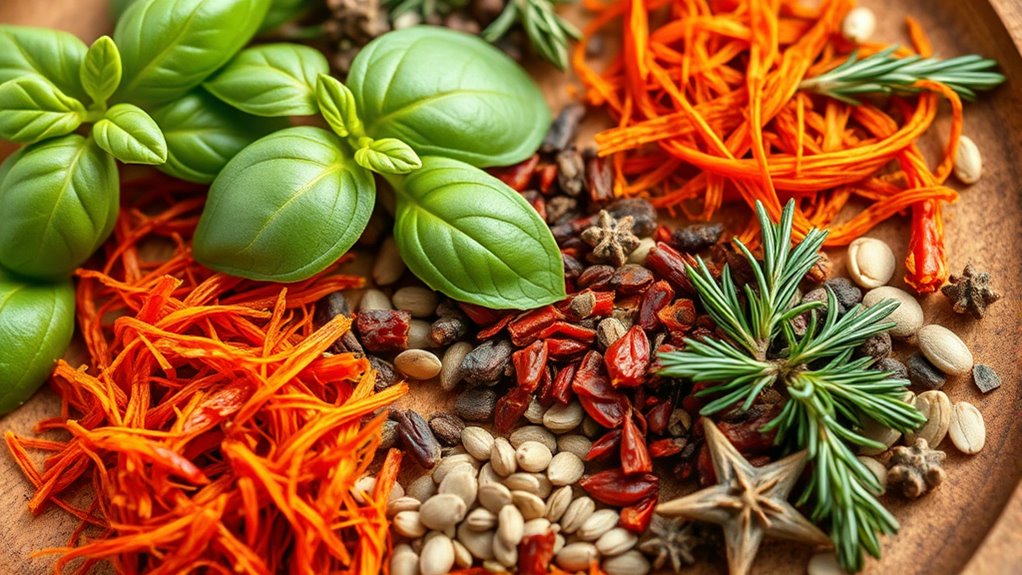
Sardinian herbs play a vital role in shaping the island’s distinctive flavors, often integrated into dishes through both fresh and dried forms. You’ll find these herbs in soups, sauces, meats, and seafood, adding depth and aroma. For example, thyme lends herbal, grassy notes to seafood and sauces, while basil brings a sweet, fresh flavor to tomato dishes and salads. Garlic provides a bold, savory taste, essential in pasta and meat prep. Oregano offers an earthy bitterness that enhances cooked dishes, and marjoram adds a mild sweetness in savory recipes. These herbs are often combined with parsley, arugula, and tarragon in traditional recipes like S’erbuzzu soup. Wild herbs, foraged or market-sourced, further enrich Sardinian cuisine with seasonal, regional flavors. Herbs are often harvested from the wild or cultivated specifically for culinary use, which allows for a diverse and aromatic range of flavors that are characteristic of Sardinian cooking. Additionally, the use of sound healing techniques can enhance the sensory experience of culinary preparation.
- Use herbs in soups like S’erbuzzu for aromatic, hearty flavors
- Combine fresh herbs with garlic and onions in sauces and sautés
- Mix herbs with meats, seafood, and vegetables for balanced seasoning
- Incorporate dried herbs into slow-cooked dishes for intensified aroma
Medicinal Benefits of Sardinian Herbs
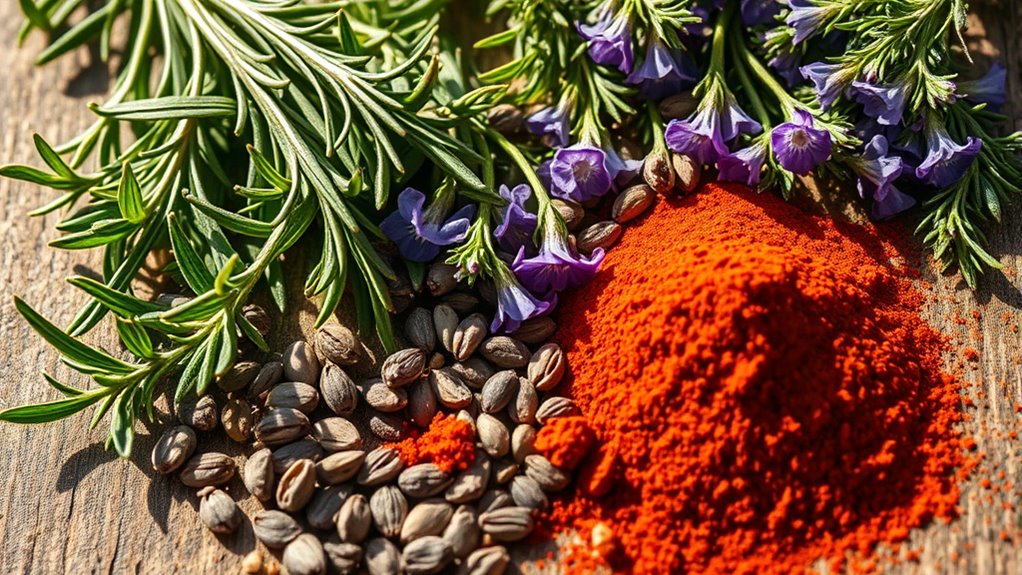
You can benefit from Sardinian herbs’ traditional medicinal uses, especially for digestive and respiratory issues. These plants also have powerful anti-inflammatory effects that help reduce swelling and pain. Exploring how their phytochemicals work may reveal even more health-promoting properties.
Digestive Aid Properties
Many traditional Sardinian herbs are valued for their ability to support digestion and alleviate related ailments. These herbs, often prepared as decoctions or infusions, are used to treat gastrointestinal issues like indigestion, diarrhea, and stomach cramps. They contain properties such as anti-diarrheal, laxative, antispasmodic, and carminative effects, helping to soothe and stimulate the digestive system. Herbs like thyme, rosemary, mastic, and basil are commonly incorporated into daily routines for their medicinal benefits. You might enjoy them as teas, condiments, or essential oils, depending on the tradition. These natural remedies are passed down through generations, making them an integral part of Sardinian ethnobotany for maintaining digestive health.
- Support digestion with thyme infusions
- Use mastic for gas relief and antibacterial benefits
- Incorporate rosemary in meals to soothe stomach aches
- Consume basil to stimulate appetite and aid digestion
Respiratory Support Benefits
Herbs traditionally used in Sardinian medicine offer notable respiratory support by soothing inflammation, clearing airways, and combating infections. Myrtle (Myrtus communis) helps alleviate bronchial issues through infusions and decoctions, while its essential oil provides antiseptic and antibacterial benefits. Inhalation or teas from myrtle can clear mucus and soothe inflammation. Thyme (Thymus species) is commonly used in infusions and inhalations to ease coughs, support bronchial health, and promote mucus clearance, thanks to its expectorant compounds. Oregano (Origanum vulgare) is valued for its analgesic and anti-inflammatory properties, helping soothe respiratory pain and boost immune defenses. Salvia (Sage) offers relief from asthma and bronchitis through its antiseptic, antispasmodic effects, reducing cough and mucous membrane irritation. These herbs work together to strengthen and protect your respiratory system. Wild herbs like myrtle and thyme are rich in essential oils that enhance their medicinal efficacy. Additionally, some of these herbs may assist in reducing inflammation and supporting immune function through their anti-inflammatory properties.
Anti-inflammatory Effects
Building on the respiratory benefits of Sardinian herbs, their anti-inflammatory properties play a key role in promoting overall health. You can harness these herbs to soothe inflammation, ease joint pain, and support skin healing. For example, helichrysum is excellent for calming allergic reactions and sunburns, while rosemary helps reduce inflammation and relieve joint discomfort. Sage offers traditional anti-inflammatory benefits, especially in mouth rinses and digestive aids. Mastic provides anti-inflammatory effects that boost wellness, and thyme infusions help treat respiratory issues and act as antiseptics. These herbs contain antioxidants and essential oils that fight oxidative stress, making them valuable for maintaining your health naturally. Notably, vetted reviews highlight the effectiveness of these herbs in various health applications.
Unique Sardinian Spices and Their Flavors
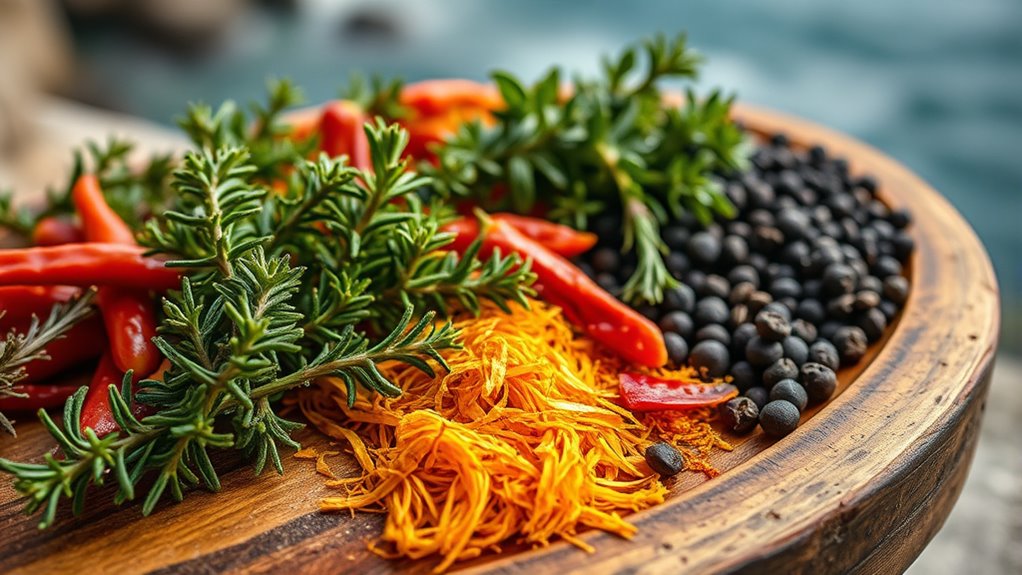
Sardinian cuisine boasts a distinctive array of spices that give its dishes unique and memorable flavors. Saffron, dubbed “red gold,” adds vibrant color and a rich aroma to seafood fregola and malloreddus pasta, elevating their taste. Myrtle brings a sweet, herbal note to herb mixes, enhancing sauces and stews. Rosemary is a kitchen staple, often paired with pasta or grilled meats for its aromatic punch. Fennel lends a subtle sweetness, particularly in traditional soups like fabadda. Laurel, or bay leaves, imparts depth to broths and stews, enriching their complexity. These spices define Sardinian dishes, blending aroma, color, and flavor that reflect the island’s culinary heritage. Their distinctive profiles make Sardinian cuisine instantly recognizable and deeply satisfying. Regional flavor profiles play a key role in shaping the island’s unique gastronomy.
Wild and Officinal Herbs in Sardinian Cuisine
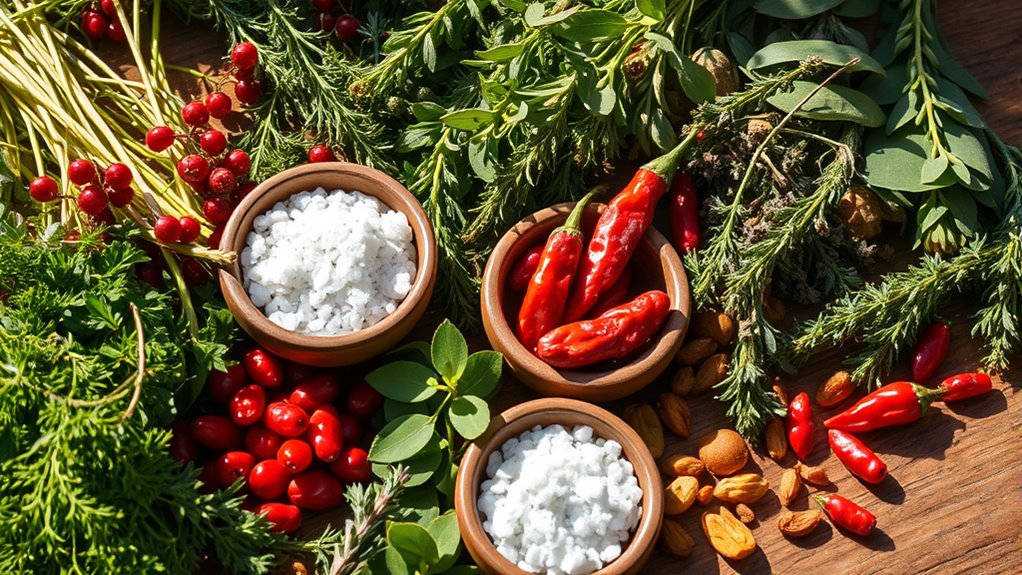
You’ll notice how Sardinian wild herbs bring vibrant flavors and health benefits to local dishes. These herbs, like wild fennel and myrtle, are also valued for their traditional medicinal uses. Incorporating them into meals highlights their unique Mediterranean character while supporting well-being. Many of these herbs are harvested from the island’s diverse landscapes and are protected by local traditions that ensure their sustainable use and preservation for future generations contributing to Sardinia’s rich cultural heritage.
Unique Mediterranean Flavors
The rich tapestry of Sardinian cuisine is deeply flavored by its unique wild and officinal herbs, which give the region’s dishes their distinctive Mediterranean character. These herbs infuse dishes with aromatic, lively, and savory notes that define Sardinian flavors. Wild fennel adds an anise-like sweetness, while mint provides a cool, revitalizing touch. Sage contributes a savory depth, and bay leaves bring warmth and complexity to stews. Officinal herbs like anise and coriander introduce subtle sweetness and spice, enhancing both sweet and savory recipes. Together, these herbs create a vibrant, aromatic profile that reflects Sardinia’s cultural heritage and local traditions. Sardinian cuisine is known for its use of these local herbs, which are often gathered from the wild or cultivated in traditional gardens, preserving age-old culinary practices. Additionally, herb gathering is a cherished tradition that sustains local ecosystems and promotes sustainable harvesting methods. – Wild fennel’s anise flavor enriches spice blends – Mint adds freshness to salads and seafood – Sage deepens savory meat dishes – Bay leaves enhance stews and soups
Medicinal Herb Uses
Wild and officinal herbs in Sardinian cuisine serve not only to flavor dishes but also to support health through traditional medicinal practices. Myrtle, with its leaves, flowers, and berries, is used to treat respiratory issues, boost digestion, and promote overall wellness through teas and liqueurs. Wild fennel aids digestion, relieves stomach aches, and is included in local dishes for its carminative effects. Chamomile, brewed as a tea, helps with sleep and relaxation, while sage soothes sore throats and reduces inflammation. Lavender is valued for calming nerves and promoting emotional balance. Other herbs like helichrysum, juniper, thyme, rosemary, and lemon verbena are incorporated into teas, oils, and infusions, offering anti-inflammatory, antiseptic, and digestive benefits. These plants remain integral to Sardinian health practices. Additionally, incorporating unique and wicked planters can enhance the presentation of these herbs in the home, making it easier to harvest and enjoy their medicinal properties daily.
Culinary Pairings
Culinary pairings of wild and officinal herbs are essential to capturing the authentic flavors of Sardinian cuisine. These herbs deepen dishes’ complexity and highlight regional traditions. Thyme, garlic, and oregano often combine in seafood and meats, creating robust, aromatic profiles. Basil adds sweetness to tomato sauces and salads, balancing savory elements. Wild herbs like parsley and arugula brighten herb soups with freshness and pepperiness. Myrtle leaves lend smoky, resinous notes to grilled meats like porceddu. Fennel seeds and anise provide sweet, licorice-like accents in sausages and stews. These pairings are carefully curated to enhance each dish’s character, blending herbs and spices seamlessly to reflect Sardinia’s culinary heritage. Additionally, herb cultivation practices contribute to the unique flavors, ensuring freshness and quality in traditional recipes.
Pairing Sardinian Herbs With Local Dishes
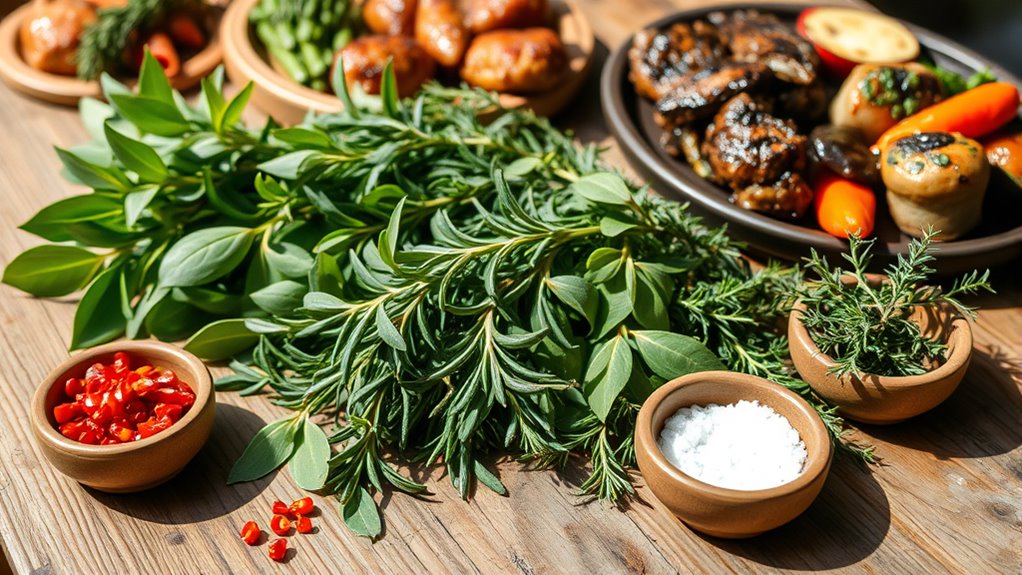
Pairing Sardinian herbs with local dishes highlights the island’s rich culinary tradition, where fresh herbs are essential for authentic flavors. When preparing meat, thyme is key for suckling pig (Porceddu), often combined with myrtle, mint, saffron, and black pepper, reflecting traditional cooking over embers or underground ovens. Garlic is indispensable in Sardinian meat recipes, boosting flavors alongside oregano and marjoram, which balance garlic’s robustness. Basil adds a sweet, fresh note to meat sauces with tomatoes and garlic, enhancing complexity. Parsley, frequently used in stuffing and as a side, provides brightness and herbal depth. For seafood and pasta, thyme, oregano, and parsley form the herbal backbone, with garlic adding savory richness. Tarragon offers a subtle, anise-like flavor in herb soups, enriching Sardinian culinary diversity. Sardinia’s unique use of fresh herbs contributes significantly to the health benefits of the traditional diet, offering antioxidants and anti-inflammatory properties that support longevity. Additionally, understanding cultural culinary practices helps appreciate how these herbs are integrated into daily cooking.
Sardinian Herbs for Digestive and Respiratory Health
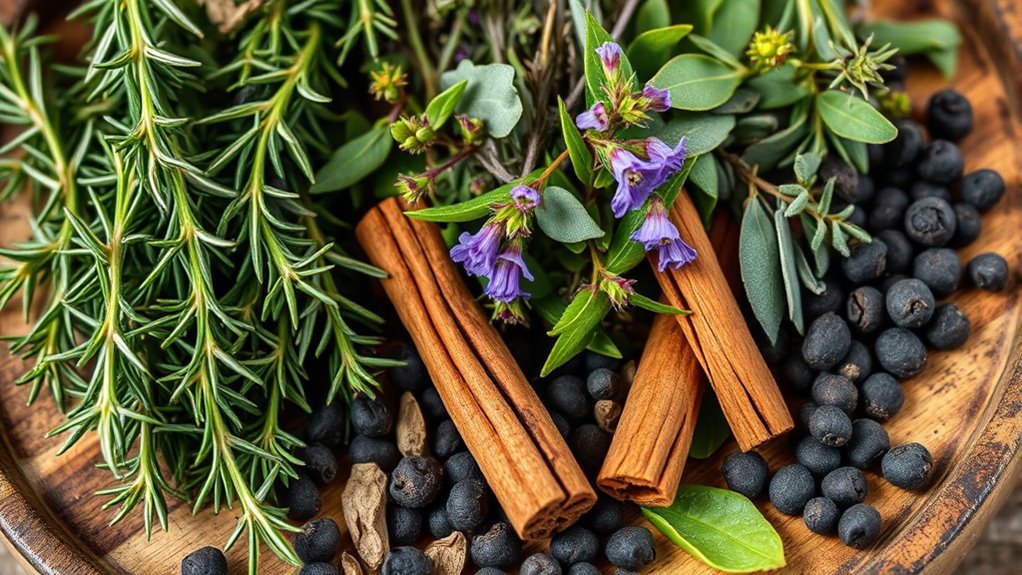
Sardinian herbs not only define the island’s flavorful cuisine but also play a pivotal role in supporting health, particularly for digestion and respiration. Myrtle, thyme, fennel, and oregano are widely used for their medicinal properties. Myrtle’s leaves and flowers help ease bronchial and respiratory issues, thanks to antiseptic and antibacterial compounds. Thyme acts as a digestive tonic and relieves coughs, with its essential oil providing anti-inflammatory benefits. Fennel, often consumed as tea, supports gut health by reducing bloating and promoting digestion through its volatile oils. Oregano offers antioxidant, antimicrobial, and expectorant effects, strengthening both respiratory and digestive defenses. It is native to the Mediterranean, especially Italy and Greece, and these herbs are integral to Sardinian herbal practices, blending flavor and health seamlessly in traditional remedies. Additionally, understanding local herbal traditions can enhance appreciation of their medicinal uses and cultural significance.
Preserving and Using Sardinian Herbs
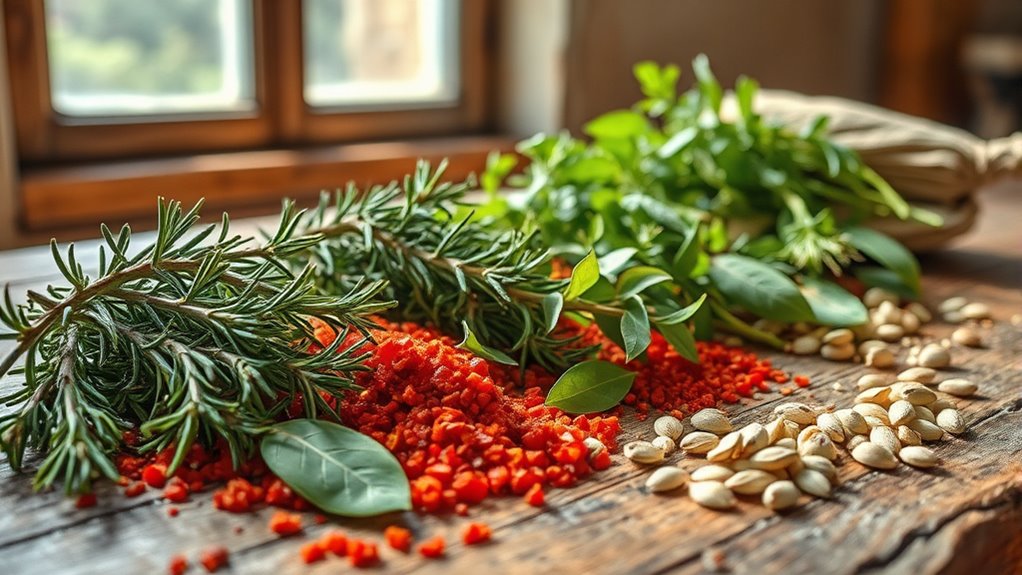
Preserving Sardinian herbs guarantees their flavors and medicinal qualities last beyond harvest time, allowing you to enjoy their benefits all year round. You can salt herbs in layers within glass jars to lock in aroma and flavor for up to a year, reusing the salt for cooking later. Freezing herbs by bundling and cutting portions helps maintain quality, especially for parsley and tarragon, and saves freezer space. Infusing vinegar with fresh sprigs creates flavorful, long-lasting herb vinegars perfect for dressings and marinades. Sun-drying herbs like myrtle concentrates their flavors and ensures preservation. Proper storage in cool, dark environments and airtight containers keeps herbs potent, while regular checks prevent spoilage. These methods let you incorporate Sardinian herbs into your cooking whenever you desire their unique taste. Proper storage techniques help maximize shelf life and preserve herb potency effectively.
Discovering Sardinian Herbal Traditions
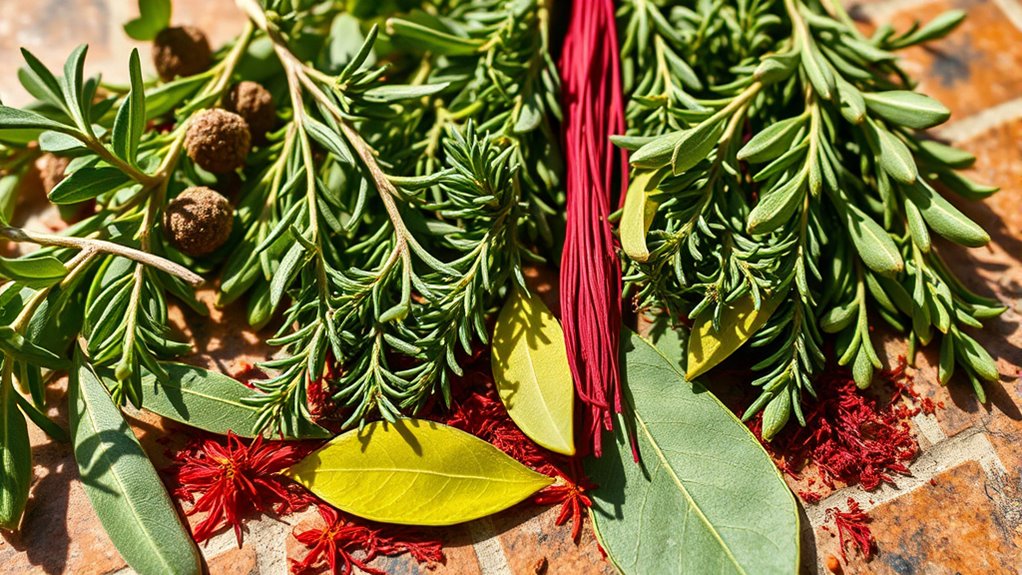
Exploring Sardinian herbal traditions reveals a rich tapestry of practices rooted in ancient knowledge and shaped by the island’s unique landscape. You’ll find that these traditions draw from classical texts like Dioscorides’ *De Materia Medica*, ensuring continuity over millennia. About 170 core medicinal species form the backbone of Sardinia’s ethnopharmacopoeia, often consisting of common weeds and plants, highlighting sustainability. Local herbal practices are less about oral stories and more about documented history, showing influence from Phoenicians, Carthaginians, and Romans. These herbs are used fresh or dried in infusions, poultices, and rituals for digestive, respiratory, and skin issues. They also support holistic wellness, blending body and mind through age-old plant-based remedies. Sardinian herbal practices have been maintained through written records and documented traditions rather than solely oral transmission. They include the use of herbs like myrtle, rosemary, and thyme for healing, as well as rituals such as Su Purtidu for spiritual cleansing. Herbal bundles are also employed for protection and prosperity, often integrated into cultural practices tied to agricultural and health rites.
Frequently Asked Questions
Are Sardinian Herbs Suitable for Vegan or Vegetarian Diets?
You’re wondering if Sardinian herbs suit vegan or vegetarian diets. The good news is, they’re naturally plant-based, with no animal products involved. Wild herbs like those in s’erbuzzu soup, along with myrtle and other aromatic plants, add flavor and health benefits without animal ingredients. You can easily incorporate these herbs into plant-based dishes, enhancing taste, nutrition, and authenticity in your vegan or vegetarian meals.
Can Sardinian Herbs Be Used in Modern Fusion Cuisine?
So, you’re wondering if Sardinian herbs can spice up your fusion cuisine? Absolutely! These herbs, like myrtle, thyme, and wild greens, add bold, authentic flavors that can elevate any dish. Marinate, infuse oils, or incorporate into doughs—your options are endless. They’re perfect for balancing rich, creamy elements or adding rustic complexity. Embrace these traditional flavors and surprise your palate with a genuine Mediterranean twist in your innovative creations.
How Are Sardinian Herbs Traditionally Harvested and Prepared?
You’ll find that Sardinian herbs are traditionally harvested by hand, often early mornings or late afternoons to preserve their essential oils. For delicate herbs like saffron, you handpick each flower and carefully remove stigmas. After harvesting, you gently dry or process them—air-drying wild herbs or rubbing saffron with olive oil—maintaining their flavor and potency. These methods honor cultural practices and ensure high-quality herbs for culinary and medicinal use.
Do Sardinian Herbs Have Any Contraindications or Allergies?
You should be aware that some Sardinian herbs can cause allergies or have contraindications. For example, thyme may trigger skin irritation or bleeding issues if you’re on blood thinners. Also, avoid fava beans if you have favism, a severe allergy common in Mediterranean populations. Always test new herbs cautiously, especially if you have allergies or health conditions, and consult your doctor if you experience adverse reactions.
What Are the Best Storage Methods to Preserve Sardinian Herbs’ Flavor?
To preserve Sardinian herbs’ flavor, you should store dried herbs in cool, dry, dark places using opaque containers. Keep them airtight to prevent oxidation and label each jar with the herb type and date. Store strong-flavored herbs separately from milder ones. For longer preservation, consider freezing or drying carefully, and avoid exposing herbs to sunlight or heat, which can degrade their essential oils and taste.
Conclusion
As you explore Sardinian herbs and spices, you’ll find that their vibrant flavors and ancient traditions are more than just coincidence—they’re a gift from nature and history working together. Embrace these aromatic treasures, and you’ll discover how they naturally elevate your dishes and well-being. Who knew that a simple sprinkle of Sardinian herbs could connect you to a land rich in flavor and tradition, turning everyday meals into memorable experiences?
